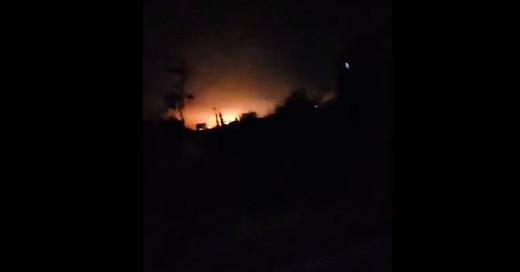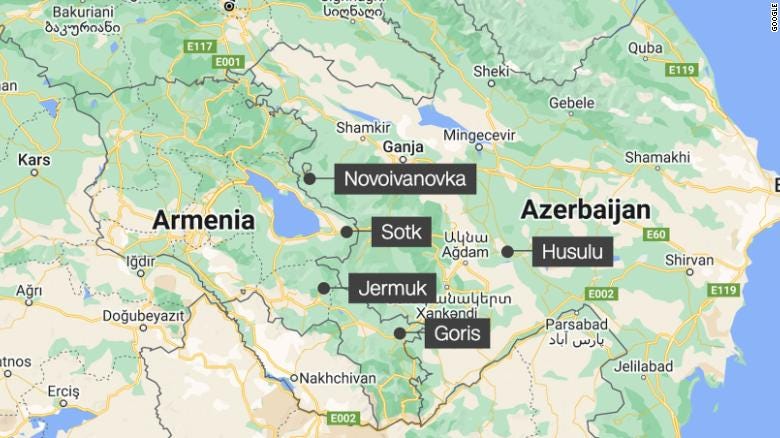Eurasia note #59 - Azerbaijan Hits Armenia With Turkish Drones
Western ally once again implicated in attack within Russian borderlands.
Azerbaijan strikes Armenian border in 7 locations killing at least 49 civilians.
Russian-led Collective Security Treaty Organization meeting; Armenia appeals to UN.
Turkish drone reported shot down in Vardenis, northern Armenia.
Ukraine reclaims 6,000 sq km of territory, along with 20 settlements.
Says will hunt down Ukrainian collaborators after retaking cities in Kharkov region.
Russian ambassador blasts Germany for undermining reconciliation since WW2.
Europe braces for bailouts as energy companies face derivatives loss of $1.5 trillion+.
EU once barred Ukraine as corrupt and dysfunctional. The EU is closing the gap.
Most Twitter activity on Ukraine is bot traffic; 90% of bots are pro-Ukraine.
Let a bot think for you — or think for yourself. What’s the choice? Subscribe.
(1,700 words or about eight minutes of your time.)
Sep 13, 2022
Clashes along the Azerbijan-Armenia border have prompted allegations of provocation from both sides.
Turkish made Bayraktar drones were reported near the disputed region of Nagorno-Karabakh, and one was shot down in Vardenis, northern Armenia.
Azerbaijan's Defense Ministry dismisses reports on invasion of Armenian territory as nonsense.
The attack prompted Armenia’s prime minister Nikol Pashinyan to call president Vladimir Putin and request Russian help. His office says he also made calls to the French president Emmanuel Macron and U.S. secretary of state Anthony Blinken, who recently returned home from Kyiv. Reports out of Armenia said citizens in Jermuk, Goris and Vardenis came under shelling and were taking shelter in basements.
Russia negotiated a ceasefire in 2020 after a 44-day war and its peacekeepers are stationed in Nagorno-Karabakh, a part of Azerbaijan with a mostly Armenian population. The 1990s saw an extended truggle for independence which ended in 1994 with the establishment of the Republic of Artsakh.
In the flare up of 2020 Russia avoided taking sides and has worked to contain conflict on another front after recent reversals in Ukraine.
Ironically Pashinyan is a favourite of the World Economic Forum and came to power in a “color revolution” in 2018. He began to target politicians close to Russia in the name of an anti-corruption drive; the same policy that was funded by George Soros’ Open Society Foundation as the Ukrainian Anti-Corruption Action Centre, AntAc.
On the other hand Armenia is a member of the Russian-led Collective Security Treaty Organization and Russia has a military base in Armenia which has historically looked to the fellow Orthodox Christian country for support.
Just over 120,000 Armenians live in Nagorno-Karabakh/Artsakh, about one per cent of Azerbaijan’s population; compared with 2.9 million in Armenia.
A brief history
The region’s complex background continues to influence events.
Once the biggest empire east of Rome, reaching into central Turkey, northern Iran, Syria, Lebanon and Israel, Armenia was the first country in the world to adopt Christianity as a state religion in 301.
In the 5th century the country was split between the Persian empire and the Byzantine, though Armenian nobles played a leading role and several of the emperors of Byzantium were ethnically Armenian.
The nation saw a revival of feudalism in the 9th century and flourished for a short time (World Economic Forum take note).
Over the past two millennia Turkic peoples have migrated from western Mongolia “into most of Central Asia from their original homeland in the Altai mountains,” as Akhilesh Pillalamarri has written in The Diplomat. Being nomadic, many of the Turkic tribes clashed with the sedentary population and some served as mercenaries. This led the Seljuk sultans to displace these families to the periphery of the Seljuk empire which bordered Hellenic Byzantium, the eastern portion of what had been the Roman empire. [1]
In 1045 the Byzantines conquered Armenia but, in massing their forces against warlike Turkic tribes, alerted the Seljuks to their potential threat. In 1071 the Seljuks, who had previously regarded Egypt’s Fatimid Caliphate as their principal rival, set their armies against Byzantium in Manzikert in eastern Turkey.
The rest is history. The largely Greek and Armenian populations came under Turkic rule. Their original genetic markers remain prominent among the Anatolian population today, while in contrast there is relatively little evidence of Central Asian descent: less than 15 per cent. [2]
This is just one story in an ancient and complex region where it is relatively easy for those with a more reductionist view of the world to make trouble. Unfortunately this includes Turkey whose president Recep Tayyip Erdoğan once talked of ending the military’s dominance in politics but now speaks of a “sacred march.” [3]
U.S. Central Command held joint exercises in Tajikistan last month, involving Kazakhstan, Kyrgyzstan, Uzbekistan, as well as Mongolia and Pakistan. The first three of those ‘stans are members of the CSTO. These mostly landlocked countries have gained new importance since China launched its Belt and Road Initiative, a land link from China to Europe. Russia also led the establishment of the Eurasian Economic Union (EAEU or EEU). These entities make China less dependent on sea routes and thus insulate it from U.S. naval power.
Another incentive for the U.S. to try to split these former Soviet republics is Iran’s growing influence in the region. It began the process of joining the Shanghai Cooperation Organisation (SCO) last year and Iran's full accession is expected next year. Tehran along with Argentina has also applied to join the BRICS group, which partly overlaps with the SCO as China, Russia and India are members.
Foreign powers continue to arm and train Ukraine so there is little doubt NATO would seize the opportunity to distract Russia’s attention by stirring the pot elsewhere on its borders or in the region. Turkey did not give its approval for gratis when Sweden and Finland applied to join NATO. It held out for concessions and possibly a free hand elsewhere. As for the leadership of European Union, anything that draws attention away from their economic crisis is welcome.
The EU could be encouraging Azeri hopes in return for its oil and gas but this is less likely as Azerbaijan ranks around 24th in the world for oil production and 30th for natural gas. But European Union leaders likely don’t know that.
Russian reversal
In Ukraine the forces of Kyiv have retaken land in the Kharkov region. NATO forces are widely suspected of involvement in the reversal of fortunes. The attack was swift and well-planned in contrast to the disarray that has marked Ukraine’s encirclement in numerous so-called cauldrons.
Although Ukraine forces attacked Balakleya, Kupyansk and Izyum, they failed to pin down their opponents who retreated eastwards to the Oskol River.
It was not the massive military defeat implied in the Western corporate-state media and Russians dispute that they abandoned a large amount of equipment. Even so it is an embarrassment to lose land it took so long to acquire.
Russian forces may have seen it coming but they had little time to reinforce and likely put too much faith in the local garrison. Unlike the Ukraine forces they have not set large minefields and on this occasion it may have cost them.
Up to 9,000 forces in Ukrainian insignia took part and the foreign involvement may have gone further than providing equipment, signals intelligence and tactical advice.
Russia replied with missile strikes on electricity stations blacking out Kharkov for a second day. Last weekend the Zaporizhzhia nuclear power plant was shut down because Ukrainian forces were shelling it. The head of Russia's Security Council Nikolay Patrushev accused the U.S. of providing Ukraine with targets and weaponry.
Ukraine is about to share the same experience, if not policy, as Western Europe: energy thirst.
The mayor of Izyum says forces will search for Russian soldiers and, after that, collaborators. Similar operations are ongoing in another Kharkov city Balakleya following its recapture by Armed Forces of Ukraine.
Reshaping reality
Keep reading with a 7-day free trial
Subscribe to Moneycircus to keep reading this post and get 7 days of free access to the full post archives.




